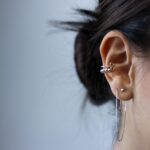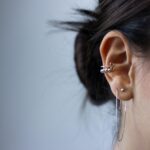Table of Contents
Belly button piercing – it’s like giving your midriff a glamorous little crown and saying, “Bow down, folks, we’re turning stomachs into royal territory!” Now, let’s pierce that fear bubble and slide into the land of studs and rings, where pain is temporary but beauty is permanent, or at least as long as you want it to be. Buckle up, lovelies, you’re in for a navel-gazing ride – and I mean that quite literally!

What Is A Belly Button Piercing?
Belly button piercings, my friends, are far from being just a fleeting trend. They are timeless, sexy, and here to stay, a personal proclamation of self-expression.
Think back to the late ’90s and the early 2000s when we saw the likes of Britney Spears and Christina Aguilera rock the navel ring – it was an emblem of their rebellion, their sex appeal, their confidence. Decades later, and guess what? We’re still pierced and proud. So, if you’re flirting with the idea of getting one, buckle up. I’m going to share everything you need to know about navel piercings – the good, the bad, and the sparkling.
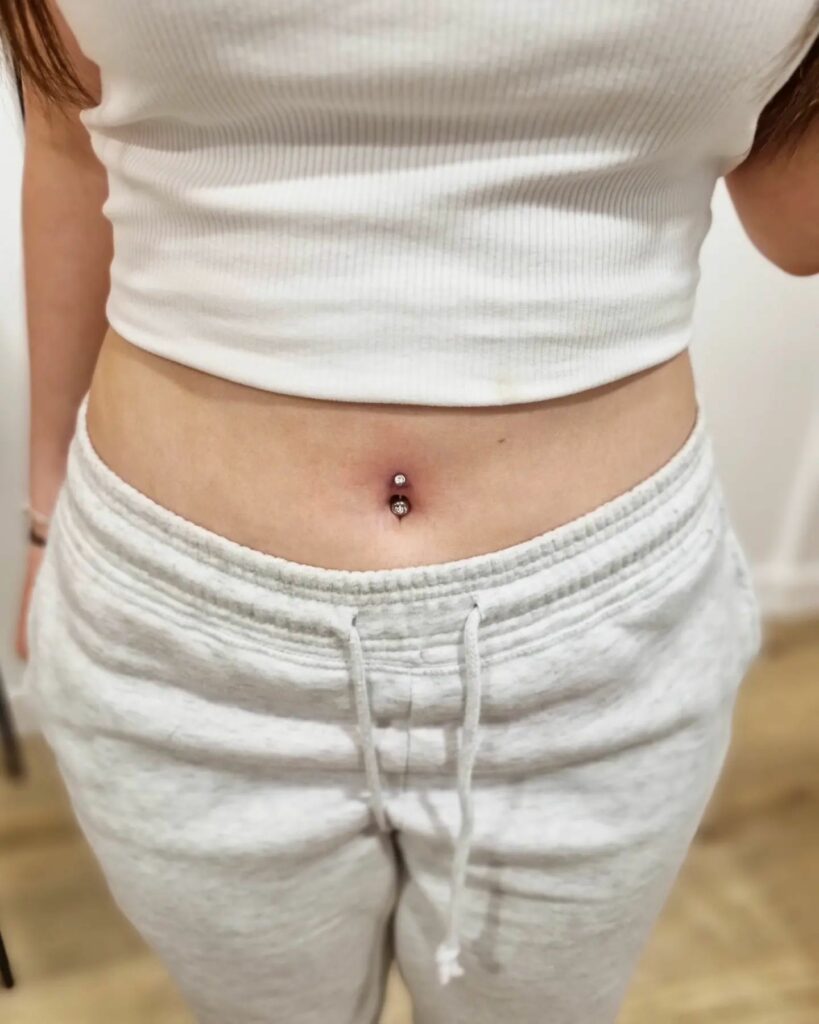
Now, you’re probably wondering, “Am I a suitable candidate for a belly button piercing?” Well, not everyone can be. Body anatomy and health conditions play a crucial role. You might be surprised to learn that the actual belly button isn’t pierced. Instead, the needle makes its home in the skin around the navel. Remember my good friend Jasmine? She had this adorable outie that she thought would look fabulous with a ring. But our professional piercer advised against it. Outies, as it turns out, don’t take well to piercings due to potential complications.
What Happens During A Belly Button Piercing?
If you get the green light, the fun part begins – picking your bling! When I got my first navel piercing, I had my heart set on a vibrant blue opal stone set in surgical titanium. My piercer, though, had a better understanding of what would work best during the healing phase. You can always change the jewelry after the area has healed completely.
Every good piercing story begins with a pair of gloved hands and a sterilized needle. Here’s a tale from my archive: the first time I got a piercing, I nervously noticed that the piercer hadn’t washed his hands. I raised my concern, and guess what? He washed his hands, put on a fresh pair of gloves, and we proceeded smoothly. If your piercer isn’t demonstrating high standards of hygiene, don’t be afraid to speak up.

The actual process of the piercing isn’t all that terrifying, honestly. I remember being prepped, my navel sterilized, and marked for precision. The seconds leading up to the piercing were far more nerve-wracking than the piercing itself. There was a brief sting, and then – voila – my belly button was looking sparklier than ever!
Don’t overlook the aftercare instructions – I can’t stress this enough. When I got my first piercing, I thought I would remember everything. How wrong I was! Jot down the dos and don’ts, and make sure you follow them diligently. And, if you’re like me and have the memory of a goldfish, you can always call your piercer to jog your memory.
How Much Do They Hurt?
Let’s talk pain, shall we? Having endured everything from a broken heart to childbirth, I can tell you that a belly button piercing is a walk in the park. It’s like a pinch on your earlobe – quick and bearable. And the post-piercing discomfort is pretty mild too – nothing a few cozy Netflix nights can’t handle.
How Much Do They Cost?
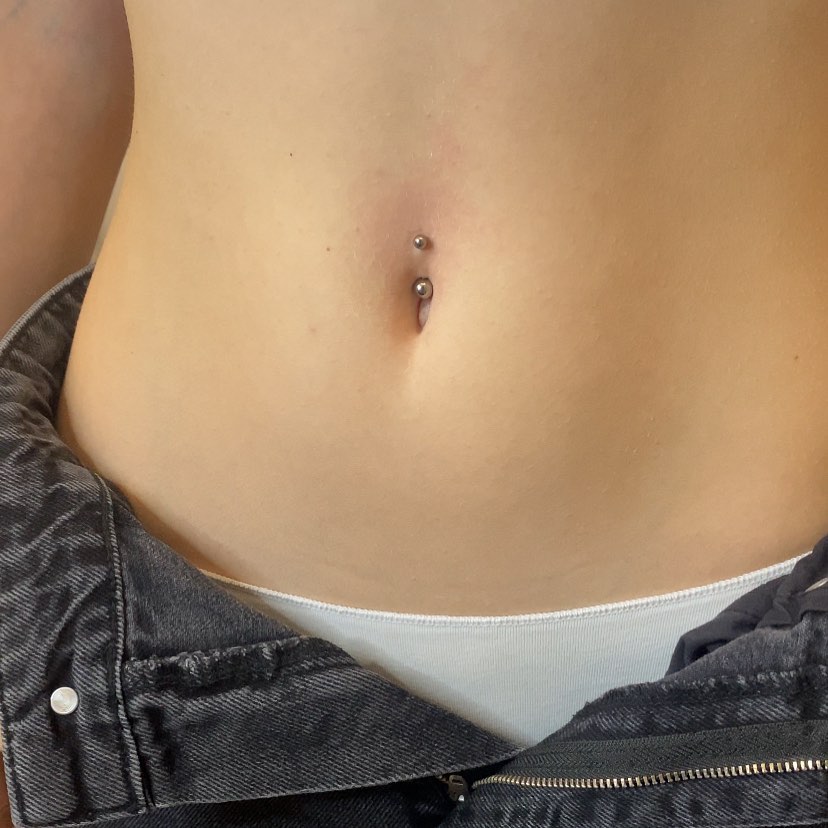
Here’s the part where your wallet takes the spotlight. A belly button piercing isn’t a wallet-busting affair, usually ranging from $30 to $60. But, remember, what you’re paying for isn’t just a needle through your skin – it’s the expertise, the safety, and the style. It’s like my mom used to say, “You get what you pay for.”
While you don’t want to skimp on quality, you can save a penny or two on jewelry. Steer clear of nickel – it might be easy on the wallet but tough on the skin. And, even though sterling silver is a popular choice, it can sometimes give your skin an offbeat hue. A better bet? Surgical titanium or stainless steel. They’re budget-friendly, durable, and unlikely to cause allergic reactions. If you’re a metal-phobe, you can opt for tygon plastic.
How Good Your Piercer Is
To wrap this up, here are a few pearls of wisdom from someone who’s been through the drill. Research your piercer, prioritize safety and cleanliness, and communicate any health issues in advance.
What To Do Before Getting A Belly Button Piercing
Choose loose, comfortable clothes for the piercing day – leave those high-waisted jeans and body-hugging tops at home. And lastly, remember to stock up on aftercare supplies like sea salt and cotton balls.

Belly Button Piercing Aftercare & Cleaning Guide
One of my most vivid memories after the piercing was how odd my belly button felt. Let’s be honest, it’s not every day a needle trespasses through your skin. The aftermath? Slight discomfort and an eerie feeling of my belly button being a tad more ‘present’ than usual. But, fear not, this is all perfectly normal.
Your belly button piercing’s success lies heavily in your commitment to a diligent aftercare routine. Think of it as a new pet that needs consistent nurturing. Let’s dive into a few essential steps you can take to ensure your piercing heals beautifully.
Sea salt, not table salt, is the unsung hero of piercing aftercare. I recall standing in my cramped kitchen, mixing a quarter teaspoon of sea salt into 8 ounces of hot water, my concoction for the perfect healing bath. Dip a clean cotton ball in the solution and apply it to your piercing. Repeat this a few times to ensure the piercing stays moist throughout the process. Alternatively, if you’re dexterous and have a knack for balancing, you can use the ‘Dixie cup method.’
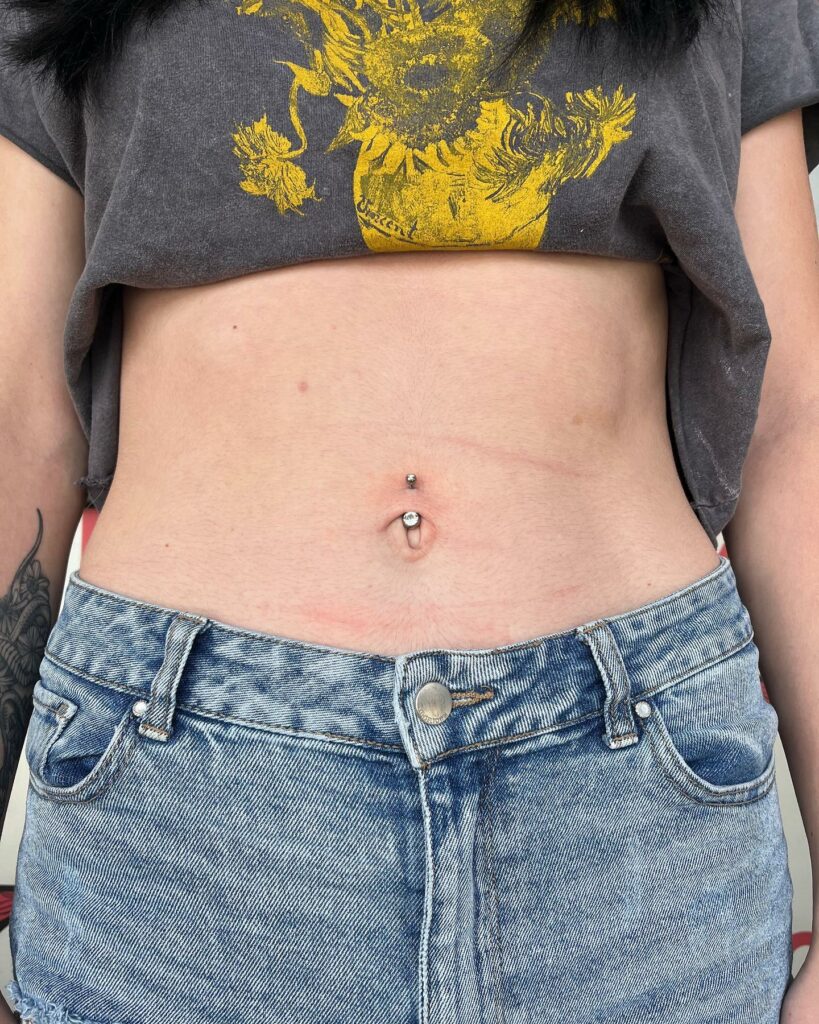
Picture this: You’re standing in your bathroom, dressed in low-rise pants and sans shirt. You’ve bent at the waist, cup rim snug around your piercing site. Carefully, you relocate to your bed or couch, making sure to keep the cup against your belly. A delicate dance of sorts, but well worth it. The warm salt water should envelop your piercing, acting as a mini sauna, cleansing and encouraging any discharge to drain.
If DIY isn’t your style, there’s a host of aftercare sprays that are affordable, effective, and mess-free. My personal favorite is the After Inked Piercing Aftercare Spray. This vegan, alcohol-free product was a savior for my sensitive skin, ensuring swift healing and minimal discomfort.
Just as you would protect your skin from harsh elements, do the same for your piercing. Keep it out of direct sunlight and refrain from using tanning beds, as dry skin can lead to itching. Remember, any foreign substance, be it sunless tanner, lotion, or even soap, can irritate the piercing. The golden rule here is to keep it clean and dry.
It’s tempting to take a dive into the pool on a scorching summer day, but for the sake of your piercing, resist the urge. Pools can harbor a plethora of bacteria that can spell disaster for your new piercing.
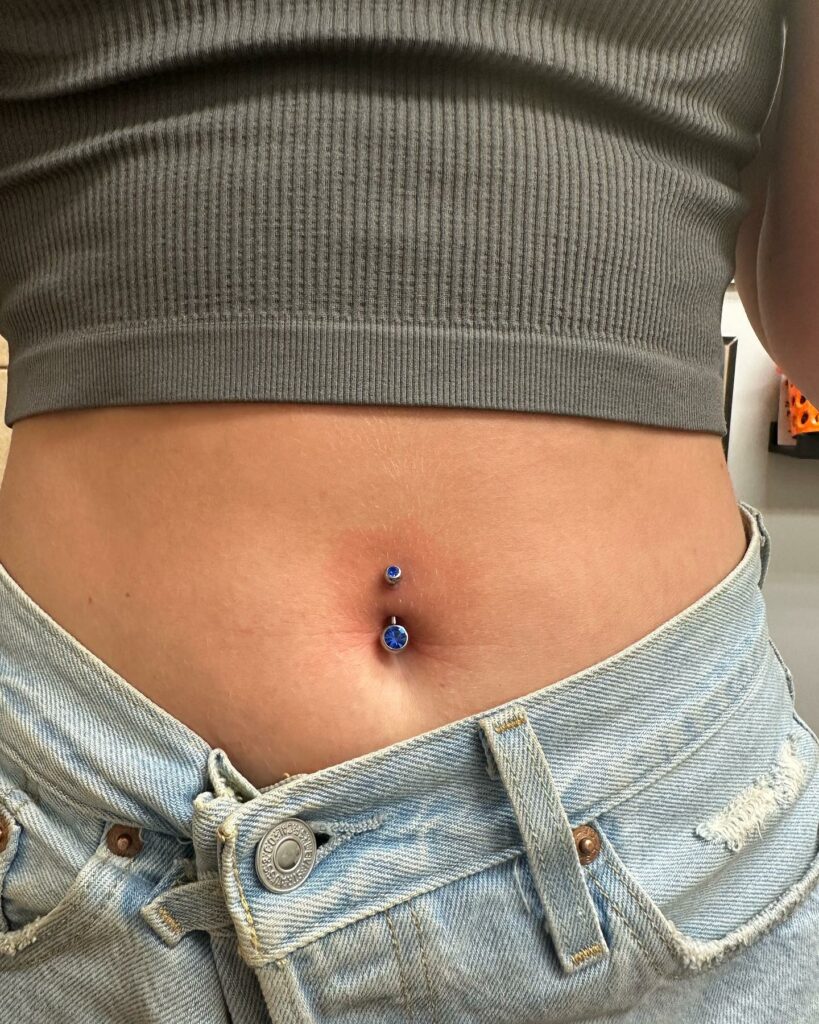
How Long Does A Belly Button Piercing Take To Heal?
5. Patience Is Key: A belly button piercing can take up to a year to heal fully. That’s right, it can take longer to heal than a broken bone! However, the average healing period lies somewhere between three to six months, with the right care and attention.
When I first got my belly button pierced, I was under the illusion that it had healed within the first few weeks. It appeared so on the surface. But, beneath the skin, the healing process was still underway.
Remember, your overall health plays a significant role in the healing process. Adequate sleep, a balanced diet, and a robust immune system can speed up healing considerably.
Belly Button Piercing Infections
Yes, it can be unnerving when your new piercing exudes pus and seems inflamed, but don’t hit the panic button just yet. Symptoms appearing in the first week post-piercing are usually standard healing reactions. However, if these symptoms surface after a couple of weeks, it might be an infection.
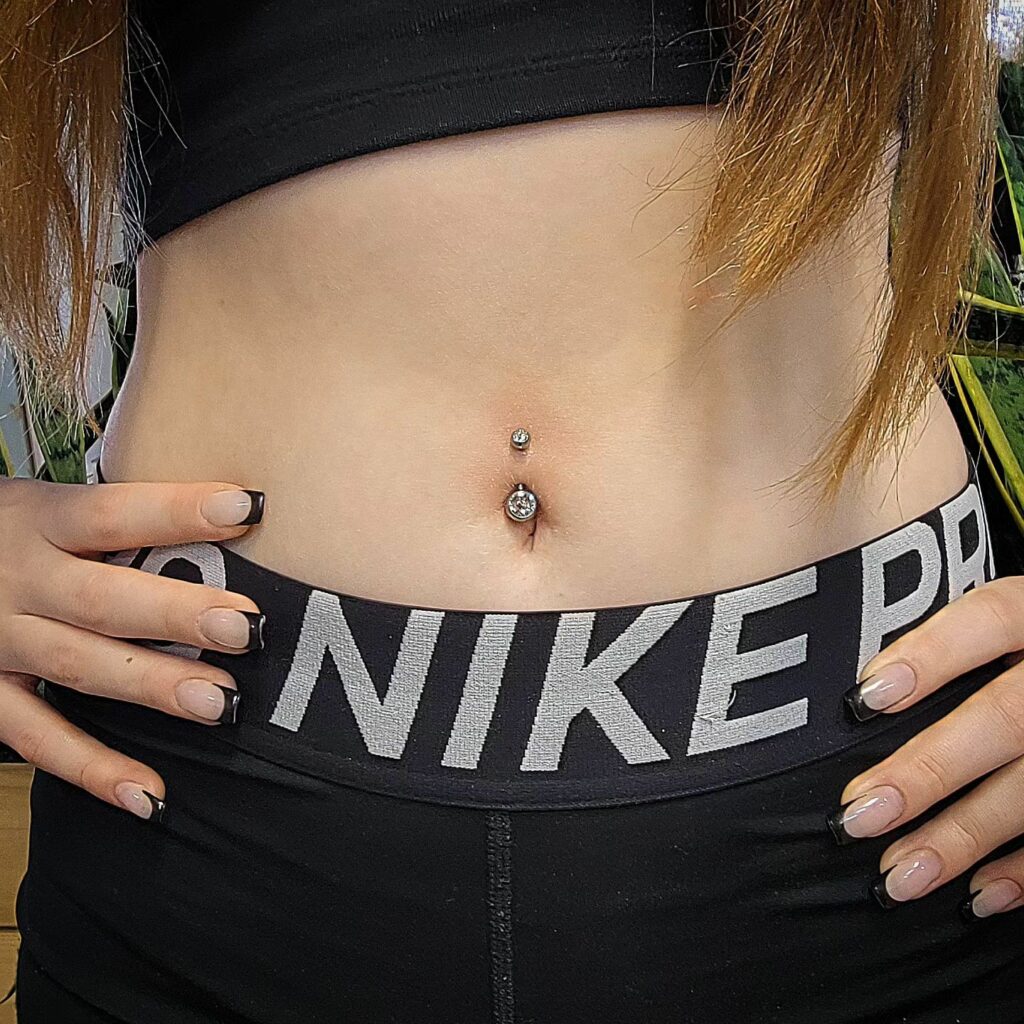
Trust your instincts and stay observant. If your piercing exudes a funky smell, the pus is not clear or white, or the skin around the area feels unusually hot, it might be time to consult a medical professional.
Taking care of a new belly button piercing may seem like a daunting task, but with careful attention and a bit of patience, the healing journey can be just as rewarding as the decision to get pierced. Keep in mind these tips and anecdotes from my own piercing journey, and you’ll be showing off your healed, beautiful piercing in no time!
Belly Button Piercing Risks
For starters, if your belly button has an outie disposition, I hate to be the bearer of bad news, but it might not be the best canvas for your piercing dreams. A reputable piercer will tell you if you’re not an ideal candidate for a belly button piercing, and I implore you to heed their advice. I’ve seen folks ignoring these warnings, chasing piercers who’d do the job anyway. I can’t stress enough how dangerous this can be. It’s not a bargain; it’s your health you’re risking.
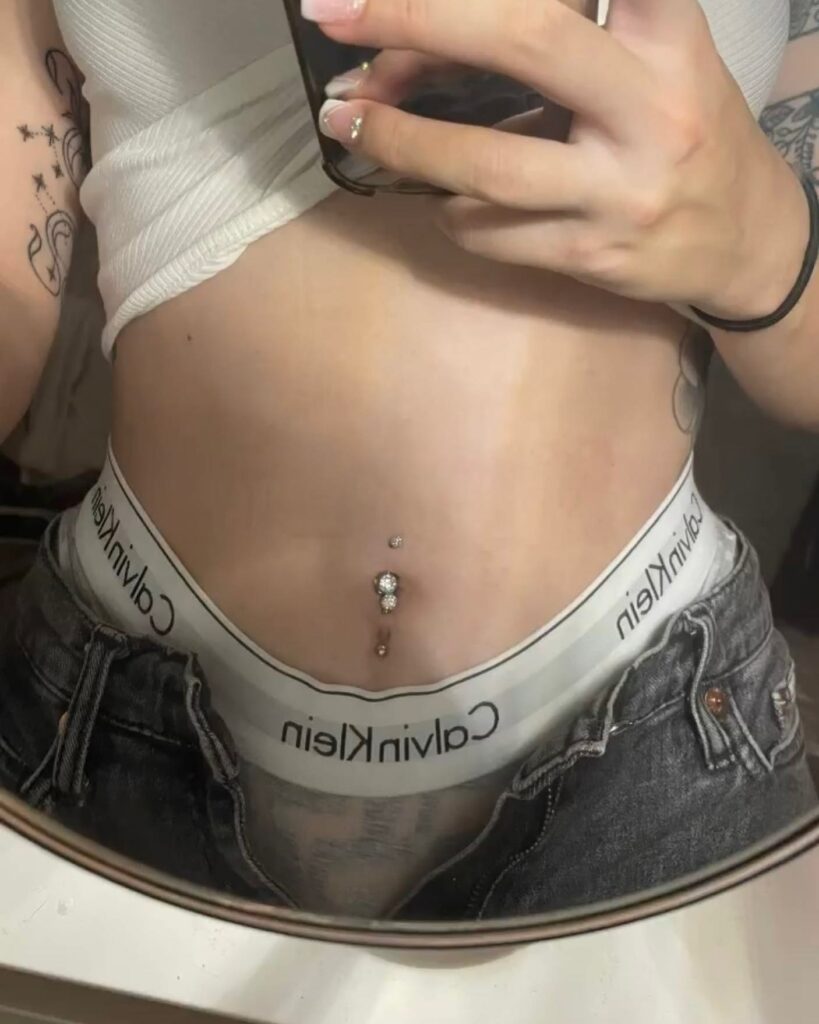
One risk to keep in mind is piercing migration. Sounds like a term out of a biology textbook, doesn’t it? It’s not that common, but knowledge is power. Migration is your body’s version of a “not in my backyard” protest. Just like it would with a pesky splinter, your body might push a piercing too close to the surface outward. This can also happen due to an allergic reaction to the metal in your jewelry. Telltale signs include itchiness, redness, and a burning sensation at the piercing site.
I remember once, after getting a new piercing, waking up to a red, itchy belly button. Panicked, I rushed back to my piercer, who calmly explained that I was experiencing a mild allergic reaction to the nickel in my jewelry. Thankfully, he replaced the offending piece with a hypoallergenic alternative. So, choose a high-quality metal, preferably one you know you’re not allergic to. If migration begins, you may have to retire the piercing and let it heal before trying again.
Pre-existing Medical Conditions To Be Aware of
there are several health conditions that might prevent someone from getting a belly button piercing or any piercing in general. Here are a few:
- Diabetes: People with diabetes often have trouble healing from wounds, which could make the recovery from a piercing more difficult and prolonged. There’s also an increased risk of infection.
- Blood Clotting Disorders: If you have a blood disorder, such as hemophilia, that affects your body’s ability to clot, piercing can be riskier due to the potential for excessive bleeding.
- Allergies: If you’re allergic to certain types of metals, you might react to the jewelry used in a piercing. This could cause itching, redness, swelling, and other symptoms.
- Heart Conditions: Certain heart conditions may put you at higher risk for developing a serious infection called endocarditis. If bacteria enter your bloodstream during the piercing process, it can cause this infection.
- Compromised Immune System: If your immune system is compromised due to conditions like HIV, cancer, or you’re on immunosuppressant medications, your body might have a harder time healing from a piercing and you’re at a higher risk of infection.
- Pregnancy: It’s generally advised to avoid any new piercings during pregnancy. The body undergoes various changes and healing might be slower. There’s also a higher risk of infection which could potentially harm the developing fetus.
Before getting any kind of piercing, it’s important to talk with a healthcare professional, especially if you have an existing health condition. They can advise you about potential risks and precautions to take. Remember, your health and safety should always come first.
Belly Button Piercing Jewellery
Don’t be seduced by a budget-friendly piercing service. It may seem appealing, but you get what you pay for. Excessive bleeding, for instance, is a risk you take when you opt for a less experienced piercer. So, invest in a skilled professional. Trust me, it’s worth every penny.
Certain metals are less likely to cause allergic reactions and will promote better healing.
- Titanium: This is the most hypoallergenic material available and is a perfect choice if you have sensitive skin. It’s lightweight, durable, and comes in a variety of colors.
- Surgical Stainless Steel: This is another safe option, especially for the initial jewelry post-piercing. It’s affordable and less likely to cause allergic reactions, although it’s not as hypoallergenic as titanium.
- Gold: Solid gold (14k or 18k) can also be a good choice, but make sure it’s not just gold-plated. Plating can chip or wear off over time, exposing underlying metals that might cause an allergic reaction. Also, avoid gold during the initial healing process as it can sometimes cause complications.
- Niobium: Similar to titanium, niobium is a hypoallergenic metal that’s safe for body piercings. It’s often available in a wide array of vibrant colors.
Avoid jewelry made of the following materials, especially for a new piercing:
- Nickel: Many people are allergic to nickel. Even a small amount can cause a reaction, leading to complications like infection or rejection.
- Plastic or Acrylic: While these materials might be tempting due to their lower price point, they can break down over time, releasing potentially harmful substances into your body.
- Silver: While it’s beautiful, silver can oxidize, leading to tarnishing and potential infection. It’s generally not recommended for new piercings, although it might be suitable for healed ones.

Now, for the fun part – choosing your belly button jewelry. Oh, the excitement of selecting the perfect piece to adorn your piercing! But remember, you’re not the expert. When my piercer advised against a particularly chunky piece I was in love with, I was disappointed, but I listened. I’m glad I did, because a heavy piece can increase the odds of migration. So, bring a selection to your piercer, and listen to their advice.
The world of belly button jewelry is delightfully diverse – metals of all sorts, barbells, hoops, and even jewels or stones that sparkle so beautifully under the disco lights. After all the discomfort and waiting for it to heal, why restrict yourself to just one look? Experiment, play around, switch your jewelry to match your mood or outfit. Just remember to be gentle, and make sure the piercing is fully healed before changing the jewelry.
Conclusion
In the vast canvas of the body, the belly button offers a uniquely charming spot for a personal emblem, a beacon of style and identity. But remember, this journey towards navel glitter isn’t just about the sparkle, it’s about the safety and the sustainability of it. Choose a professional piercer, even if it means shelling out a little more cash, usually around $30 to $70. The initial discomfort, the cautious waiting for the piercing to heal, are all part of the process. Let’s not forget the risks involved, such as migration, infection or allergic reactions, which are rare but noteworthy. It’s always better to be informed than ignorant. But if done right, a belly button piercing can be an enchanting addition to your persona. So, let’s embrace the sparkle but tread with caution. After all, body art is about self-expression, and there’s nothing more expressive than looking after ourselves while we shine.


